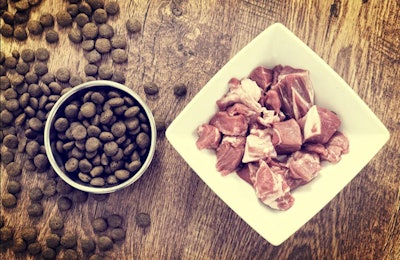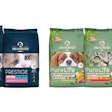
Over the past decade, at least 10 scientific studies have examined raw dog and cat food. These peer-reviewed journal articles and federal studies attempted to determine how raw diets affect dogs, cats and their owners, including identifying potential health risks.
-
Raw pet food as a risk factor for shedding of extended-spectrum beta-lactamase-producing Enterobacteriaceae in household cats – Plos ONE - 2017
In November 2017, scientists published research results suggesting that raw cat food may harbor antibiotic-resistant bacteria that could be passed to humans, either through the food itself or feces.
-
Differences in the gut microbiota of dogs (Canis lupus familiaris) fed a natural diet or a commercial feed revealed by the Illumina MiSeq platform – Gut Pathogens - 2017
Scientists at Seoul National University in South Korea found eating homemade raw dog food for more than a year correlated to different microbes thriving in dogs’ intestines compared to the guts of dogs fed store-bought dry kibble. The dogs eating a raw diet harbored a wider range of microorganisms, and larger populations of them, including bacteria that can cause health problems.
The potential risk of opportunistic infection could be higher in companion canines fed raw dog food, than in dogs fed commercially available dry kibble, wrote the scientists.
-
Bacteriophages safely reduce Salmonella contamination in pet food and raw pet food ingredients - Bacteriophage - 2016
Scientists demonstrated that viruses, called bacteriophages or phages, can knock down Salmonella levels in raw pet food ingredients and are safe for dogs and cats to eat.
Bacteriophages are viruses that infect bacteria. Since phages live nearly everywhere on Earth, they can meet consumers’ demands for pet foods made using natural ingredients without synthetic chemicals, wrote the researchers.
-
Isolation of Campylobacter spp. from Client-Owned Dogs and Cats, and Retail Raw Meat Pet Food in the Manawatu, New Zealand – Zoonoses and Public Health - 2016
Scientists investigated the prevalence of Campylobacter spp. in dogs, cats and retail raw meat pet food products in New Zealand. Campylobacter spp. were isolated from 28 percent, C. jejuni from 22 percent, C. lari from 6 percent and Campylobacter coli 6 percent of raw pet food samples.
-
Investigation of Listeria, Salmonella, and Toxigenic Escherichia coli in Various Pet Foods – Foodborne Pathogens and Disease - 2014
This study found evidence that raw pet foods may harbor food safety pathogens, such as Listeria monocytogenes and Salmonella.
-
Fecal microbiota and metabolites of adult dogs fed extruded, mildly cooked, and raw diets. - Journal of Animal Science - 2017
In an experiment, dogs fed either extruded, raw or lightly cooked dog foods ended up with different species of bacteria and other organisms in their feces. Those results give clues about how raw types of diets influence dog health, digestion and the community of organisms, called microbiota, in dogs’ intestines.
“Not surprisingly, given how the chemical composition, level of processing, and nutrient digestibility among diets differed, the extruded diet was quite different than the mildly cooked and raw diets,” study co-author Kelly Swanson, professor of animal and nutritional sciences at the University of Illinois, told Petfood Industry.
-
Pet food testing for selected microbial organisms - USDA - 2013
In a two-year study spanning from October 2010 through July 2012, the FDA Center for Veterinary Medicine (CVM) screened over 1,000 samples of pet food for bacteria that can cause foodborne illnesses.
-
Evaluation of four raw meat diets using domestic cats, captive exotic felids, and cecectomized roosters - Journal of Animal Science - 2013
Researchers analyzed the value of nutrients from bison, cattle, horses and elk meats to test how the different diets affected cats, both domestic cats and big cats in captivity. Findings indicated that although raw meat diets met many of the nutrient requirements for cats, none of the diets contained the recommended levels of linoleic acid, and horse meat did not provide recommended levels of arachidonic acid for kittens, as well as gestating and lactating females.
-
Availability, Brands, Labelling and Salmonella Contamination of Raw Pet Food in the Minneapolis/St. Paul Area – Zoonoses and Public Health - 2012
Researchers purchased sixty raw meat diets representing 11 different brands from eight different stores. Although those stores promoted raw meat diets they didn’t post food safety warnings, noted the study authors. While four of the 60 raw diets (7 percent) tested positive for Salmonella in laboratories, the raw pet food labels often lacked foodborne illness warnings.
-
The risk of salmonellae shedding by dogs fed Salmonella-contaminated commercial raw food diets – The Canadian Veterinary Journal - 2007
Laying the ground work for the Plos ONE study a decade later, scientist fed 28 dogs one meal of intentionally Salmonella-contaminated commercial raw food diet meal in a 2007 study. Seven of the exposed dogs shed salmonellae one to seven days after eating the Salmonella-contaminated raw dog food, but none of the dogs fed Salmonella-free diets shed salmonellae. The researchers concluded that dogs fed Salmonella-contaminated raw food diets can shed salmonellae and may be a source of environmental contamination potentially leading to human or animal illness


















